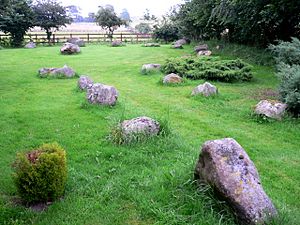Sarsen facts for kids
Sarsen stones are large, tough blocks of sandstone. You can find many of them in the United Kingdom. They are common in places like Salisbury Plain and the Marlborough Downs in Wiltshire. You can also find smaller amounts in Kent, Berkshire, Essex, Oxfordshire, Dorset, and Hampshire. These stones are what's left of a very hard rock layer called silcrete. This layer once covered much of southern England. Silcrete is a dense, strong rock. It forms when sand gets glued together by a natural cement made of silica. Think of it as a super-hard sandstone. Scientists believe these stones formed over millions of years. This happened as sand and other materials turned into rock due to natural processes like weathering.
Contents
What Does "Sarsen" Mean?
The word "sarsen" is a shorter version of "Saracen stone." This name came from the old Wiltshire dialect. In the past, "Saracen" was a common word for Muslim people. Over time, it started to mean anything that wasn't Christian, including things seen as pagan. So, "Saracen stone" meant a stone that seemed foreign or unusual.
How Have People Used Sarsen Stones?
Sarsen stones have been very important throughout history.
Ancient Monuments
The people who built famous places like Stonehenge used these huge stones. They used them for the tall upright stones in the main circle. They also used a sarsen stone for the heelstone. This is a single stone standing outside the main circle. Many other ancient stone circles and monuments in southern England, like Avebury, are also made from sarsen stones. These ancient builders moved and set up these massive rocks without modern tools.
Building and Construction
Later on, people found ways to break sarsen stones into smaller pieces. They sometimes used fire to heat the stones. This made them crack. In more recent times, explosives were used. However, sarsen wasn't always the best material for building houses. An old writer named William Stukeley noted that sarsen stones could feel "moist and dewy" in winter. This made houses damp and unhealthy. It could also cause furniture to rot.
For example, people who tried to build houses with sarsen stones in Avebury faced problems. The houses were hard to sell. They also tended to catch fire easily. Despite these issues, sarsen stones were still valued for how strong they were. They were often used for things that needed to last a long time. This included steps and kerb stones along roads.
See also
 In Spanish: Sarsen para niños
In Spanish: Sarsen para niños


